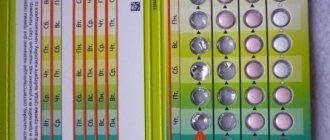If there are any disruptions to the menstrual cycle, we can talk about problems with female sexual health. Therefore, it is so important that all women are attentive to any changes and the appearance of incomprehensible symptoms, especially changes in vaginal secretion. The appearance of a brown spot scares many women, but there is no need to panic, because the phenomenon does not always indicate gynecological problems. If a light brown spot appears, which a woman can detect on her underwear a couple of days before the start of menstruation, this phenomenon is acceptable. Saturated brown discharge indicates problems in the body. Why do I have brown discharge but no periods? What are the reasons for the phenomenon? What do we have to do?
Adolescence
In girls during puberty, the menstrual cycle is irregular. Failures are observed during the first two years after menarche. This is a normal situation, since menstrual function is developing, hormonal levels are constantly changing.
Spotting instead of menstruation two years after its onset is a reason to consult a doctor and undergo an examination.
When should you not worry?
When discharge instead of menstruation has physiological reasons, you should not worry.
These include the onset of sexual activity. This phenomenon can be observed during the first days of the menstrual cycle. This is due to the slow rejection of the functional layer of the uterus. Blood comes out in small quantities, as a result of which the discharge becomes dark in color. This result is caused by interaction with the oxygen environment and microorganisms located in the vagina. Spotting is considered normal after the birth of a child and during breastfeeding. A woman's reproductive system needs time to recover. After childbirth, the discharge is heavy at first, but its intensity gradually decreases and as a result, brown spotting appears instead of menstruation. During lactation, female hormonal levels change.
If menstruation is smeared brown, but does not begin in a woman over 40 years old, it can be assumed that the reason is the decline of reproductive function. During menopause, egg maturation stops. The female body ceases to perform reproductive function.
The first sign of these changes is irregular menstruation. The volume of discharge decreases and it turns brown. Accompanying signs of menopause may include hot flashes, increased sweating, rapid heartbeat and sleep disturbances. In some cases, these symptoms are observed in women after 38 years of age.
Menstruation occurs, but does not start for a long time due to surgical intervention. The cause of scanty discharge can be operations to remove polyps, fibroids or part of the uterus, termination of pregnancy, curettage and laparoscopy. If your period does not have an unpleasant odor, there is no reason to panic.
The intensity and color of the discharge may also change under the influence of external factors. This:
- stress;
- unbalanced diet;
- excessive physical activity;
- excess weight.
Excess body weight causes hormonal imbalance. The results of this are disappointing. Bloody discharge during menstruation becomes scanty. Strict diets also lead to such consequences. If your period does not go normally, this may be the result of taking contraceptives.
Cycle disruption can also occur in women taking contraceptive medications. The action of these drugs is aimed at preventing ovulation. The body slows down the production of estrogen hormones, which prevents the development of the endometrium (the mucous membrane in the uterine cavity). Therefore, the discharge may take on a dark brown color. But this condition should not last longer than 3 months. Another reason for spotting may be irregular sex life.
As already mentioned, healthy women experience menstruation every month with an interval of 21-28 days. At this time, the uterus begins to cleanse itself of the rejected mucous epithelium and blood that accumulates in it throughout the entire cycle.
Ideally, periods should last 3-4 days, but for some women they last up to 7-10 days, which is also normal, unless, of course, other signs of pathology appear. During menstruation, about 50 ml of blood leaves the female body. The bulk of menstrual blood is released in the first 1-2 days, and then brown spotting begins.
The color it turns brown rather than red is due to the fact that the blood is already secreted in small quantities and reacts with oxygen, causing it to oxidize and acquire this color. And it is for this reason that brown daub instead of menstruation can drain the sour aroma.
Therefore, if menstruation smears and does not go as expected, while the woman recently visited a gynecologist and no health problems were identified, there may be several reasons for this - prolonged menstruation (in this case, spotting can occur several days before menstruation, and after them) and the impact on the body of some negative factors, among which are:
- Excessive consumption of alcoholic beverages.
- Taking certain medications, in particular oral contraceptives.
- Psycho-emotional exhaustion.
- Stress.
Quite often, delayed periods and brown discharge are observed in young girls and women over 40 years of age. In the first case, this is due to an unsettled cycle, and in the second, due to the rapid onset of menopause and the complete extinction of reproductive function. Therefore, the appearance of small delays and smudges should not cause much concern. You need to see a doctor only if these phenomena are observed systematically.
Pregnancy
Spotting appears as a consequence of conception. The fertilized egg moves into the uterine cavity, where it attaches to the mucous membrane.
The process of penetration into the endometrium is accompanied by damage to small blood vessels. Implantation bleeding occurs. Next comes a delay.
If a woman already knows about her situation, then bloody smear is an alarming sign. It may indicate a threat of miscarriage, which happens, for example, with hormone deficiency. Urgent medical attention is needed.
Embryo implantation
Climax
After 40–45 years, scanty discharge is more often a symptom of the onset of menopause, subject to protection. There is a gradual decline in reproductive function, depletion of the ovaries, and a decrease in the level of hormones produced.
As a result, full menstruation is replaced by spotting, and menstruation does not occur.
If a woman has regular sexual intercourse, does not use protection or was careless, pregnancy should be ruled out using a test or blood test for hCG.
Causes of spotting instead of menstruation
There are many reasons why your period suddenly ends - from physiological to pathological. The latter, as a rule, are often accompanied by general malaise, pain and fever during menstruation.
Among the causes of menstruation with abnormal duration and nature of discharge are:
- pregnancy;
- hormonal disbalance;
- sudden climate change;
- sudden weight loss;
- menopause;
- period of menstruation.
Pregnancy
A completely normal pregnancy, of course, does not involve any bleeding, but nowadays, due to the sharp deterioration in public health, this often occurs. Conception involves a delay in menstruation, so a woman during this period may mistake spotting of another origin for it - both physiological (for example, implantation bleeding) and pathological, which can end sadly:
- Ectopic pregnancy.
- Frozen pregnancy.
- Risk of miscarriage.
Thus, if the nature of menstruation is strange, the first step is to exclude the onset of conception using a simple urine test for the level of hCG, which increases sharply during pregnancy.
Hormonal disbalance
Hormonal imbalance is the main cause of abnormal periods. The unpredictability of this disorder is that it can affect any phase of the menstrual cycle. So, with a low level of estrogen, an outcome is possible in which the egg will not be able to leave the ovary into the abdominal cavity, that is, ovulation will not occur.
Another manifestation of changes in hormonal balance is the deficiency of the second female hormone - progesterone. It regulates the process of building up the functional layer of the mucosa; accordingly, if it is deficient, this does not happen. When the time comes to evacuate the egg by tissue rejection, there is so little of it that it is not enough for normal menstruation - menstruation begins and ends every other day.
Climate change
A sharp change in climate is stressful for the body. Indeed, along with climatic conditions, both the time zone and the biological clock, tuned to a certain periodicity of day and night, change significantly; for some time they are “at a loss.” Cyclic disruption may also be associated with this.
After some time (after adaptation, acclimatization or return to normal conditions), menstrual days begin again at normal times, the nature and duration of the discharge normalizes.
Sudden weight loss
Sharp weight loss is usually caused by a combination of a strict diet and large, unusual physical activities for the body. Girls in pursuit of an ideal figure doom themselves to problems with menstrual periods.
Such lifestyle changes, like climate change, are a serious stress for the body, which needs time to adjust. Accordingly, while the body adapts to the new loads and diet, the discharge may be very scarce, and even a sudden cessation of menstruation is possible.
Climax
Menopause and menopause are natural states of the fairer sex, whose reproductive age is gradually ending. The functions of the gonads and ovaries gradually fade away, they undergo involution.
However, if you alternate between spotting and heavy uterine bleeding, you should consult a gynecologist, since such situations are often markers of serious pathologies.
In young girls (under 18 years of age), the menstrual cycle is just beginning to form, so there are frequent cases of abnormal periods. During the period of menarche (14–16 years), when puberty ends, there are often problems with the required concentration of sex hormones and infantilism of the organs of the female reproductive system.
Thus, during the period of establishing the frequency of critical days, you do not need to worry much about the strange nature of the discharge, possible delays and the lack of a clear cyclicity. By the end of puberty, all processes associated with the reproductive function of the female body are normalized.
Hormonal contraception
Taking contraceptives reduces the functioning of the ovaries. The supply of hormones from the outside changes the process of their synthesis in the body. An altered balance of estrogen and progesterone affects the pattern of menstruation.
Spotting within 2-3 cycles after starting to take the pills is a reason to consult a doctor. It is necessary to change the dosage or select a different drug.
Similar symptoms are caused by an installed intrauterine device. One of its side effects is scanty spotting of a light brown color.
Venereal diseases
Brown discharge can also signal the development of sexually transmitted diseases, which require immediate treatment. Their development is characterized by infectious damage to the organs of the reproductive system and can cause a delay of up to three or more days.
As a rule, with the development of sexually transmitted diseases, brown periods after a delay are accompanied by unpleasant sensations in the intimate area - itching, burning, irritation, etc. And if your periods are spotting and are accompanied by similar symptoms, then this is a serious reason to go to the doctor and take all the necessary tests to identify STDs.
Ectopic pregnancy
Characterized by an abnormal location of the embryo. In an ectopic pregnancy, the embryo does not reach the uterine cavity and attaches in an uncharacteristic place - for example, in the fallopian tube or cervix.
Pathology can cause spotting brown discharge. Diagnosed using ultrasound. Requires surgical intervention.
Inflammation and infections
Inflammatory processes in the pelvic organs occur as a result of hypothermia and poor hygiene. Adnexitis and endometritis affect the appendages and uterine cavity, causing uncharacteristic discharge - spotting, scanty, which lasts up to 2 weeks.
Infectious diseases are the result of unprotected sexual intercourse with an untested partner. Associated symptoms:
- pain in the lower abdomen;
- burning and itching in the perineum;
- brown or other colored vaginal discharge with an unpleasant odor.
Attention! Diseases transmitted through sexual intercourse include chlamydia, trichomoniasis, syphilis, gonorrhea and others.
Pathological conditions
Vaginitis
This is one of the reasons that leads to the appearance of spotting instead of menstruation. Most often, this is a process that takes quite a long time and is accompanied by defects in the mucous membrane.
The pathogen in such cases is predominantly nonspecific.
For many women, this cause of spotting instead of menstruation causes a lot of inconvenience, such as itching and burning in the vagina.
This is another common reason for the appearance of smears instead of menstruation.
It is characterized by the fact that the normal formation of a full-fledged endometrium does not occur, as well as its rejection during menstruation.
Most often these are women of reproductive age from 25 to 40 years.
The inflammatory process occurs due to the attachment of nonspecific microorganisms.
This causes significant discomfort and inconvenience for a woman. Often accompanied by the appearance of pain in the lower abdomen.
Cervical cancer
This is one of the most dangerous conditions in which spotting occurs instead of menstruation.
Typically, a similar picture is typical for later stages of the process. In such a situation, tissue breakdown and destructive processes develop.
This process is predominantly preceded by long-term erosions, which subsequently turn into dysplasia.
The most oncogenic among them are types 16 and 18. The type of cancer process that causes spotting can be different, it is either a limited process associated with cancer in situ, or invasive tumor growth.
Spotting instead of menstruation can appear at rest, or be caused by tissue irritation, for example, sexual contact or examination. And also in a calm state, menstruation can lengthen in duration, mainly after their end.
The smear with this pathology can be brown or crimson with streaks of blood or pieces of tissue. The woman’s general well-being is also affected; she notes a deterioration in her condition, decreased appetite, constant fatigue, and a rapid drop in body weight. Subsequently, pathologies of urination and defecation are added.
This is another reason for the development of spotting instead of menstruation. In this case, such a picture can be considered both normal and pathological.
Normal spotting may be associated with long-term use of oral contraceptives.
Therefore, instead of a normal menstruation, a woman sheds a small amount of tissue and therefore only a small amount of brown spotting appears. This picture appears no earlier than six months after regular use.
But in some cases, spotting may appear instead of menstruation, which occurs after starting to take oral contraceptives. This may be due to the fact that hormonal changes in the body occur, but they are not always fully established.
Installation of the spiral
This is one of the reasons that leads to the appearance of spotting instead of menstruation.
This can happen due to several reasons:
- First of all, this may be a reaction to the introduction of an object foreign to the body, which has direct contact with a normally aseptic environment. Since it is recommended to install the IUD on one of the last days of menstruation, when the cervix is not yet completely closed, this creates less pain.
- In addition, an initial inflammatory aseptic process may occur, so the menstruation during which the IUD is installed is delayed for several days and is accompanied by the discharge of smear instead of the usual bloody discharge.
- Also, in some women, spotting instead of menstruation or in the middle of the cycle may be associated with the incorrect position of the intrauterine device in the cavity. In most cases, she can independently name the reason why the IUD is mixed. Most often this is heavy physical activity or rough sexual contact.
The spotting is accompanied by the occurrence of pain, as well as pain radiating to the sacrum and coccyx.
They belong to the group of diseases that lead to the development of severe inflammatory reactions. In this case, the process is of a specific nature.
They all have one predominant route of transmission, sexually. The most common species include gonococci, chlamydia, trichomonas, and cytomegalovirus.
For a long time they do not manifest themselves in any way, only later this can result in low-grade inflammation, menstruation can change its cyclicity, they become longer, more abundant and painful.
Before and after the appearance of menstruation, she notices spotting; in most cases it is brown in color. The consistency is liquid, there may be small veins resembling pieces of fabric.
These will be endometrial tissue or areas of clotted blood. The process can be irreversible, which leads to infertility or the most common complication - adhesions.
This is one of the factors that provokes the occurrence of spotting in a woman instead of menstruation.
This problem in the modern world is widespread in modern society, since a woman regularly has to deal with unfavorable factors, one of which is stress.
Symptoms:
- It may manifest itself as a shift in the menstrual cycle, its delay or complete absence of menstruation.
- A woman may notice the appearance of such an unfavorable symptom as a shift with spotting.
- The color of the discharge can vary from pale pink to brown.
- The duration also varies; in some women, such a symptom lasts no more than two or three days or is a one-time occurrence.
- Sometimes they are accompanied by pressing pain in the lower abdomen, as well as a feeling of weakness and malaise. But a small number of women face this problem, which lasts for several months.
This is a whole group of pathologies that can manifest as spotting instead of menstruation.
These include primarily hormonal diseases, as well as structural anomalies.
The last group includes various pathologies in the structure of organs, in particular the uterus.
The most common case is considered to be a doubling of the uterus, this can be any type of saddle-shaped, horseshoe-shaped and other types. In some cases, incomplete doubling may appear, which will have a separate outlet into the vagina and the process of releasing menstrual blood will be delayed; a woman will notice the appearance of spotting for a long time.
Other diseases
Among other diseases, it is customary to highlight the currently widespread internal endometriosis.
This process is characterized by severe pain. Menstruation is characterized by prolongation of periods, with a brown spot appearing before and after the appearance of the main discharge.
This is due to the process of endometrioid tissue leaving other cavities. Such daubing can last up to 2 - 3 weeks, the volume will depend on the degree of damage to the organ.
Weight change
Sharp changes in body weight, up or down, always affect the menstrual cycle. Why are there incomplete periods? There is a dysfunction of the hypothalamus and changes in hormonal levels.
As a result, a woman’s periods begin to smear, but do not come fully. The situation is dangerous due to the complete disappearance of menstruation and loss of reproductive function.
Obesity and strict diets with rapid weight loss should be avoided. Nutrition should be balanced.
Other factors
Other causes of cycle irregularities, scanty or inconsistent menstruation:
- stressful conditions, depression;
- bad habits;
- poor nutrition;
- insufficient sleep;
- violation of metabolic processes;
- climate change.
All these factors negatively affect the health of girls and women. For good health, you need a balanced diet, frequent walks, moderate physical activity, adherence to a sleep schedule, and giving up bad habits.
In the video about the reasons
https://youtu.be/p7UAjPjaP7k
Obvious problems
If your period lasts for a week and then stops altogether, this indicates problems in the body. But scanty menstruation does not always indicate significant deviations. Frequent companions of this condition are:
- Headache.
- Nausea.
- Constipation.
- Feeling of tightness in the chest.
- Pain in the lumbar region.
Sometimes girls only notice that their periods are a little anointed and that’s it, without paying much attention to the accompanying symptoms. But doctors are confident that it is the additional symptoms that confirm the deterioration of the woman’s health in general.
How to treat
In case of spotting, instead of menstruation, the doctor prescribes an examination.
The choice of therapy depends on the established diagnosis:
- Bleeding during pregnancy is eliminated with drugs that reduce uterine hypertonicity.
- For endometriosis, hormonal medications are prescribed. In advanced forms, curettage of the uterine cavity is indicated.
- When menopause occurs, hormonal and herbal medicines help normalize the cycle, which at the same time eliminate the severe manifestations of menopause.
- For tumor formations, treatment is conservative or surgical. Depends on the type of education.
- Spotting while taking birth control pills either goes away on its own after 2-3 months as a result of the body’s adaptation, or requires dose adjustment.
We recommend reading the article about thick periods with clots. From it you will learn about the causes of such discharge, possible diseases that affect the nature of menstruation and the need for treatment.
Why does my period last 1 day? Read about the reasons here.
Treatment procedure
Doctors should prescribe treatment based on the results of the examination. Therapy is aimed at eliminating the cause of the disorders. If menstruation takes a long time to start due to an ectopic pregnancy, surgical intervention is performed. For oncological pathology, complex therapy is prescribed.
Antibacterial drugs are also used for brown discharge. Sexually transmitted diseases are eliminated by taking antibiotics. If you don’t have your period, but it’s anointed with brown during menopause, then you will need hormonal therapy.
Folk remedies
Traditional treatment methods are recommended to be combined with folk remedies. A disease such as endometritis can be treated with lemon and orange. Scroll the fruits through a meat grinder. Then add 2 tsp. sugar and onion peel tincture, which you make in advance. To prepare it you need 2 tbsp. l. Pour this ingredient into 1 liter of hot water and keep it on low heat for a quarter of an hour. Take the mixture 1 tsp. 3 times a day for a week.
When treating herpes, chlamydia and trichomoniasis, it is recommended to use the following composition. To prepare it, you will need several ingredients. Take 2 tbsp. l. rose hips, 1 tbsp. l. nettle, lavender flowers, lingonberry leaves and elderberry flowers, pour 400 ml of boiling water and leave for two hours. Drink the composition after meals three times a day, 100 ml. The course of treatment should last no more than two months.
And also if you smear brown at the beginning of your period, you can use the following recipes:
- 1 tbsp. l. dried oregano, pour 500 ml of boiling water, leave for 40 minutes, then filter and drink 200 ml 4 times a day before meals;
- 1 tsp. pour crushed parsley seeds into two glasses of cold water and leave for 8 hours. Take 0.5 cups four times a day. Instead of infusion, you can use seeds, which should be consumed in 1.5 g doses;
- mix 1 tbsp. l. tansy and wormwood, 3 tbsp. l. lovage and oregano, 4 tbsp. l. canteen quinoa. Then 3 tbsp. l. pour the resulting mixture into 1 liter of hot boiled water and leave, take 0.5 cups 6 times a day.
Gynecologist's recommendations
The basis of treatment is identifying the causes of spotting and eliminating it. In case of such failures, you must go to the clinic, undergo an examination and follow all the doctor’s recommendations.
A single menstrual cycle disorder can be restored independently. In some cases, proper rest, proper nutrition, moderate physical activity, and giving up bad habits help.
All information is provided for informational purposes. Do not self-medicate. At the first sign of disease, consult a doctor.










